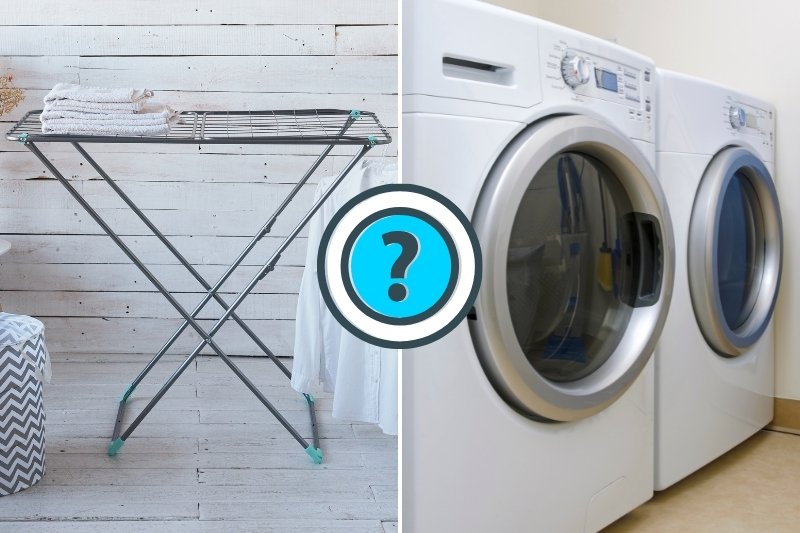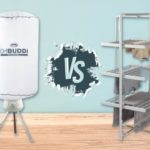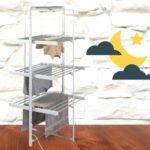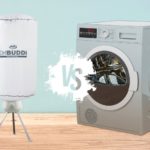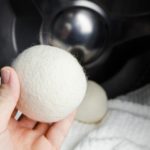If your tumble dryer has recently taken its last spin, you might be thinking about buying a new one, or you may be contemplating changing course and getting a heated airer instead!
With so much hype about both machines, and loads of reviews to read through, it can be a chore to figure out what’s actually the best option…
So, what’s the better appliance? Join me and discover what’s superior: a heated airer or a tumble dryer!
The rainy weather here in the UK means that we cannot always dry clothes outside on the line, so our go-to backup options are usually using a heated airer or a tumble dryer to dry clothes.
And with so many versions of both appliances to choose from, and so much information to think about before buying a new dryer, it can be tiresome trying to decide what the best option for your home is.
But you’ve come to the right place! Below you’ll find a comparison between tumble dryers and heated airers to help you figure out what’s the best.
Which Can Dry More Laundry at Once?
One of the main differences between a heated airer and a tumble dryer is the amount of laundry you can actually dry.
Tumble dryers come with various drum sizes, and the size of the drum you choose impacts how much drying you can do.
The drum sizes you can get usually range between 6 kg to 11 kg. It’s up to the user to decide what size drum they want based on their circumstances, but, of course, the larger the drum the more laundry you can fit in.
One of the real benefits of getting a tumble dryer is that you can run several loads of laundry through it over the course of a day, regardless of drum size.
Being able to dry multiple loads of different types of laundry per day can significantly decrease the amount of drying work you have to do over a week.
Heated airers can usually handle between 10 and 15 kg of wet laundry at a time.
Many heated airers offer about double the drying capacity of a regular tumble dryer.
However, having more space isn’t always better, as it. You’re probably not going to be drying several loads of laundry in a day with a heated airer, because a single drying process will be quite slow.
It’s likely that you’ll put one load of laundry onto the airer, and it’ll be left there for a good few hours to dry thoroughly. Depending on the materials you’re drying you might even have to leave the clothes all night too.
You’ll likely be drying a second load of laundry the next day if you’re using a heated airer. And you might have to continue to work like this until all your laundry is dry.
In the time you’d have waited for your laundry to dry you could have run at least two, if not more, cycles in a tumble dryer!
So, while a large heated airer can dry more clothes at once, you can dry more clothes per day with a tumble dryer since it will dry them more quickly.
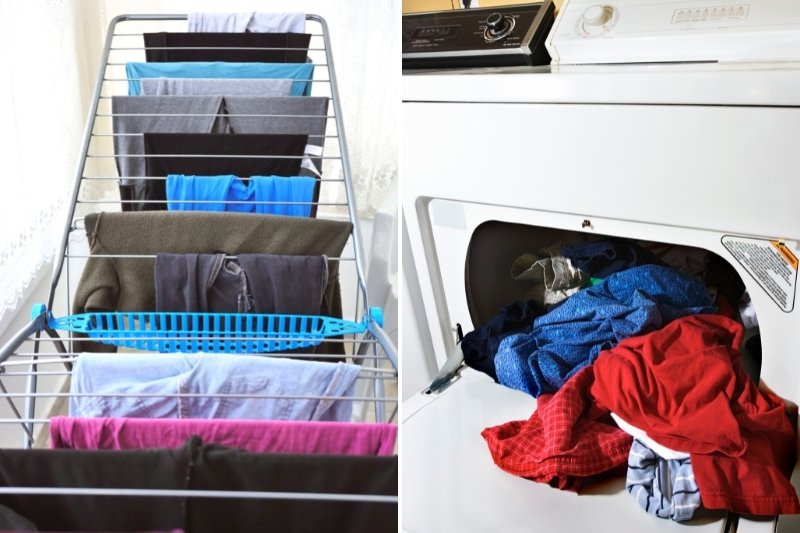
Which Dries Laundry Quicker?
A tumble dryer will certainly be able to dry your laundry faster for you. With a click of a button your items get exposed to heat and they start to rotate in the drum. This action, in turn, dries your laundry for you.
Standard tumble dryer programs only take about 45 minutes to dry light loads of laundry, though cotton cycles can take much longer, especially on heat pump machines.
A tumble dryer is the ideal appliance to have in your home if you’re in a rush, you need lots of washing dried quickly, or if you forget to wash and dry your clothes ready to go out!
Plus, you can pick an appropriate drying program to dry your clothes on when using a tumble dryer, and this can prevent you from ruining your items.
That being said, if you’re the type of person that just throws clothes into the dryer, and picks a random setting, you do run the risk of damaging your items in the dryer, regardless of how quick they dry. The intense heat and rotation may shrink or snag the material.
On the other hand, a heated airer dries laundry much slower, so users often notice that their clothes last and feel nicer on.
Heated airers can take from four to 10 hours to dry clothes, depending on the thickness of the materials you are drying.
The longer drying process isn’t always a big hit with people because it can take ages to dry some basic items of clothing. For example, thicker clothing like woolly jumpers can take 10 hours to dry. However, it will dry them in a much more gentle way than a tumble dryer would, without the risk of shrinking.
So, if speed drying is what you’re after, a heated airer probably isn’t going to be for you. But if you’re super organised with your laundry, and you don’t mind your washing being dried over a period of time, a heated airer may just be what you’re looking for.

Running Costs
Before comparing the running costs of a tumble dryer to a heated airer it’s crucial to remember that the different makes, models, sizes, general usage and wattages of both appliances heavily impact how much these machines cost to run.
So, before purchasing either of these products you should do a quick calculation to see how much you’re likely to pay based on the energy usage of the appliance you intend on buying, how often you dry clothes, and you need to consider the amount you pay for electricity now.
You’ll get a better idea of how much you’ll be paying per week if you do this!
Heated airers are typically cheaper to run in comparison to tumble dryers, especially when you consider that they can typically dry about twice as much as a tumble dryer at once.
A 300-watt heated airer will use 0.3 kWh of electricity per hour. If you were to assume that a heated airer is left on for eight hours, it would use a total of 2.4 kWh of electricity to dry about 10-15 kg of clothes. With current energy prices of 26.35p per kWh for the Energy Price Cap (EPC) period from 1 October to 31 December 2025, drying your clothes with a heated airer would cost £0.63.
The average condenser tumble dryer uses about 5.1 kWh to run a full load on a cotton cycle, costing £1.34 at current prices.
This would mean that a heated airer costs half as much to run as a condenser tumble dryer, while drying twice as much laundry.
However, running a shorter tumble dryer cycle and/or using a heat pump dryer rather than a condenser or vented model can be much cheaper than the £1.34 quoted above. For example, a one-hour cycle on a heat pump dryer could cost as little as 15p.
With both tumble dryers and heated airers, overall energy usage depends on many factors including how energy efficient your machine is, exactly what you are drying and how much you’re drying at once. Tumble drying can still be cheap and energy efficient if you’re using one of the latest heat pump models.
More and more tumble dryer manufacturers are working towards making their appliances more energy efficient, so if you look around you will find models that have lower running costs in comparison to other older models of tumble dryers.
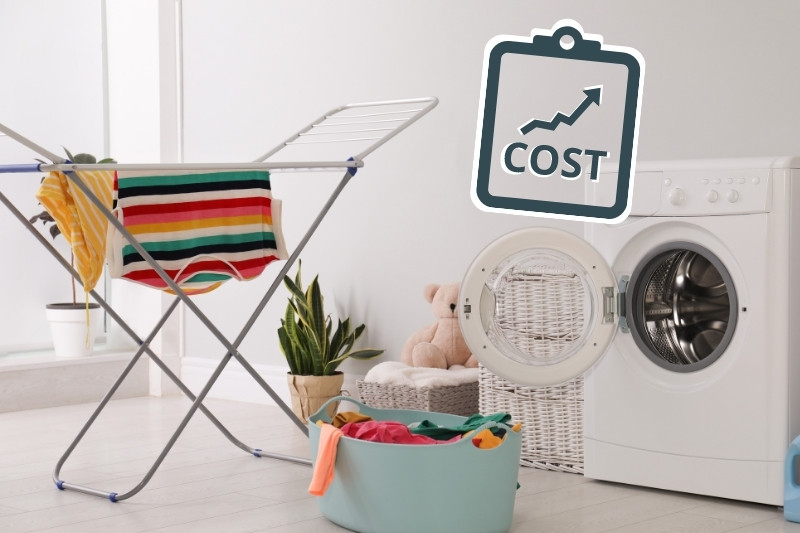
Cost of Buying a Heated Airer vs. a Tumble Dryer
Tumble dryers often cost a lot, lot more than heated airers to buy. Some of the most basic tumble dryers will set you back around £150, and the top end ones will be about, if not over, £1,000.
Higher-end tumble dryers are often heat pump models, have A+++ energy ratings, and have exceptional drying abilities. Which is why the price is so much more!
Lower end tumble dryers, on the other hand, don’t always have such a good energy rating, they don’t always dry clothes evenly, and they can sometimes cause dampness in a home. So, if you’re going to go down the tumble dryer route it might be worth paying that little bit extra!
A very basic heated airer will cost about £40, and a top notch one will cost about £200, which is much cheaper in comparison. However, heated airers don’t have all the fancy features of tumble dryers, but if you’re happy to overlook this you could find yourself a great bargain!
When thinking about getting a tumble dryer, you will need to think about the actual size of the appliance required, what type of dryer you need, what drum size you want and what technical features you desire. Each one of these factors will impact the price you pay.
Similarly, the size of the heated airer you want to buy, how much clothes it can hold, wattage, whether it has a cover and any other extras you decide to pick up, will add to the price of your heated airer.
Which Is More Practical?
To answer this question, you need to think about your personal home life. What type of house you have and what kind of lifestyle you run will impact what dryer you get.
If you have a busy home where lots of kids and pets run around all day, for example, it might not be the best idea to have a large heated airer sitting in the middle of a room. It could easily get knocked over and someone could get hurt.
In this case it might be better to go with a tumble dryer option, budget and space permitting, because the dryer would fit neatly into your kitchen and you wouldn’t know it was there. With the dryer out of the way there’s less chance of someone pulling it over.
In addition to this, you could also dry lots of clothes ready for school all at once too!
Or you could use a heated airer during school hours if you were definitely set on getting one.
In contrast, a single person who does very little washing per week, may not need to invest in a tumble dryer.
A heated airer would be more practical in this case because it could dry enough clothes for one person, it could be folded and packed away neatly, and there’s less risk of it falling over in the home when it’s in use.
You should always choose the option that is safest and most practical for your unique setup. This could be a tumble dryer, a heated airer, or perhaps both! It’s entirely up to you to decide what’s most practical.
Which Dries Clothes Better?
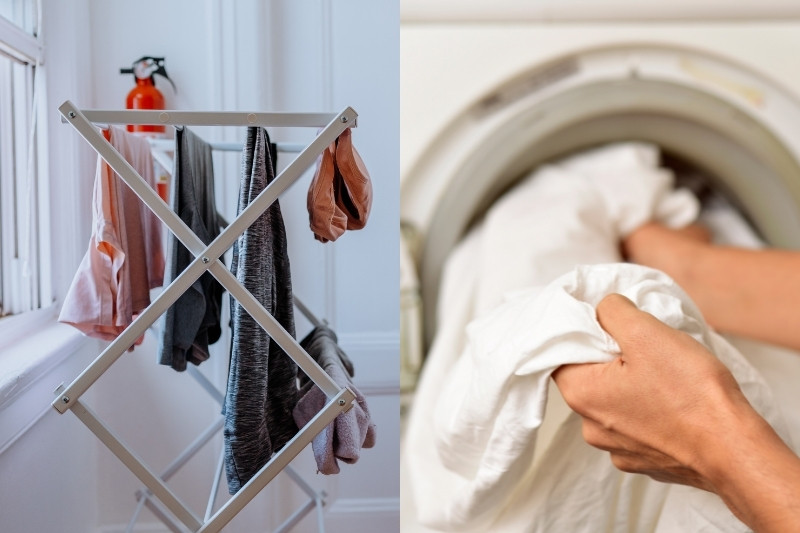
If you check what clothes you’re going to dry and dry them on the correct setting in a tumble dryer, there’s no reason why the clothes won’t dry properly.
However, if you don’t adhere to the user manual, and you add too many clothes or choose the wrong drying cycle, then you might end up with ruined or damp clothes at the end of the program.
In addition to this, some cheaper models of tumble dryer have been known to dry clothes a little unevenly, so keep this in mind.
On the other hand, although the drying process of a heated airer is typically much longer than that of a tumble dryer, users often comment that their clothes feel better and last longer when they’ve been dried in this manner.
That being said, you might have to adjust your laundry regularly on a heated airer to ensure that the items are dried entirely. This may be added work in the long run.
Overall, both appliances will dry clothes to a good standard, if they are used in the right way.
Which Is Quietest?
If you’re looking for a quiet drying option then a heated airer is the most suitable one for you. Heated airers produce very little noise, so if you did want to use the airer at night it wouldn’t hinder you too much.
Tumble dryers, on the other hand, are known for being loud. That being said, new models are quieter than older models, and you can buy quiet tumble dryers. But you can still hear them when they’re on!
However, being able to hear that the appliance is actually on may not be a bad thing. If you were going out, for example, you’re more likely to hear the tumble dryer going and you’d go back to switch it off before leaving. The sound is like an added safety feature!
Which Is Easiest to Use and Maintain?
You can compare how easy these appliances are in two ways: How easy it is to use, and how easy it is to maintain.
Let’s take a look at both in more detail.
Ease of use
It’s easy to use a heated airer and it’s simple to use a tumble dryer too.
When you buy both appliances, they’ll come with instructions on how to use the machine, and if you’re still having trouble, you can always watch a tutorial on YouTube to help you on your way!
Generally speaking, once both machines are plugged into the mains, you just flick a switch/ turn a dial to switch the dryer on. You can then pick a heat setting or choose a cycle to run. All you have to do then is wait for the laundry to dry or for the cycle to end.
Maintenance
Both appliances can be maintained with ease, although a tumble dryer has more intricate parts to clean, but it really isn’t too difficult to maintain it.
It’s always best to check your user manual first before you start cleaning either appliance. But in general, you have to wait for a heated airer to go cold before wiping it down with a cloth.
In the case of a tumble dryer, you will have to clean individual parts inside the machine, these include the drum, the filter, the condenser box and the exterior.
Neither cleaning exercise should take you very long to complete, and you should keep on top of the maintenance! Don’t go for weeks on end without cleaning either appliance as this may hinder how well it works.
Models, Sizes and Shapes
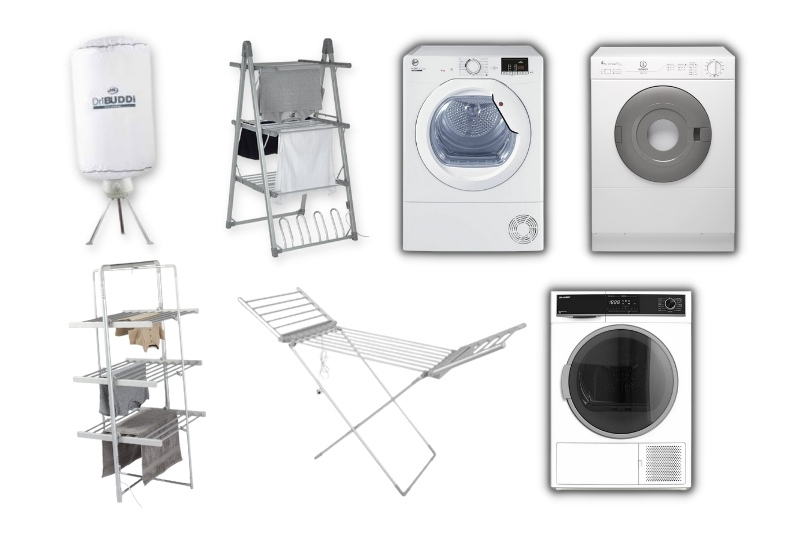
In terms of shape, a standard tumble dryer typically looks like a big box that has a door on the front where you pop your clothes in.
Tumble dryers do come in different sizes, for example some are narrower than others, and you can buy them in different colours too.
In addition to the above, you can get vented, condenser and heat pump tumble dryers, so you can choose a particular model to suit your home.
There are several brands that make tumble dryers, and these include AEG, Beko, LG and Miele.
In contrast to this, heated airers can come in different shapes. You can get tall and upright heated airers with a cover and winged dryers.
Upright heated airers are great for saving space and for drying dresses in, and winged dryers, on the other hand, can be quite big and bulky to handle.
You can pick up heated airers in shops like Dunelm and Lakeland, and you can also buy them online. One big name to look out for when shopping around is Dry:Soon, their heated airers are often highly rated by users!
There’s often plenty of choice to choose from when it comes to what shape and model dryer you want to buy. And as long as you pick a reputable name, and buy from a well-known company there shouldn’t be any problem with either option.
Of course, do keep in mind that if you choose to pick a dryer that’s made by a lesser-known company then you need to read up on the item you plan on buying.
Find out the product’s features, research what people say about the appliance, and make sure you know that the dryer is safe.
In the case of a heated airer, for example, you don’t want to purchase a flimsy airer because it’s likely to fall down when you pop your laundry on it.
Conclusion
Heated airers and tumble dryers are great at what they do! There are, of course, benefits to getting one over the other, and there are also negatives.
But in the end, it really does boil down to your unique situation.
If you, for example, know for sure that you’re going to be doing lots of drying on a daily/weekly basis, and you know you need your items dried quickly, then a tumble dryer is for you.
A heated airer wouldn’t be as suitable in this case because you’d be limited to how much laundry you could dry at once, and items would dry much slower too.
On the flipside, if you don’t have the space for a tumble dryer in your home, and you need a dryer that is more compact and can be stored away, then a heated airer would be for you.
A tumble dryer wouldn’t be practical for you because you wouldn’t have anywhere safe to store it.
Benefits of getting a tumble dryer:
- Easy to use.
- Can dry clothes quickly.
- Specialised cycles to dry clothes.
- Some models come with fancy tech built in.
- Dryers can dry a couple of items in a few minutes – perfect when you’re in a rush!
- Various drum capacities – can dry bigger loads at once.
Drawbacks of getting a tumble dryer:
- Initial buying costs are usually a lot.
- Energy costs differ significantly between makes and models.
- Vented models may cause damp if not used correctly.
- Might shrink or damage some items of clothing, if not used properly.
Benefits of getting a heated airer:
- Cheap to buy initially.
- Cheap running costs.
- They’re easy to use.
Drawbacks of getting a heated airer:
- Long drying sessions.
- You need room to set up an airer, particularly the winged models.
- You might need to rearrange your house when using a heated airer, so it fits in the room.
- Risk of dampness.

Before you dash off to buy your new dryer, here’s a quick recap of what you should consider when buying a heated airer or a tumble dryer:
1. How much laundry are you planning on drying per week?
If you do a lot of washing per week, you will naturally do a lot of drying per week too. So, you need to be able to dry large amounts of washing as quickly as possible. Leaving wet or damp washing sitting around makes it quite smelly, and it’s just not very nice.
So, a tumble dryer would be the better option to use in this case. You’d be able to wash, dry and store clothes all in one day!
If you’re planning on doing small loads of washing, then you could use a heated airer to dry your little piles of laundry during the week. This may work out more economical for you in the long-term too!
2. How fast do you need your laundry dried?
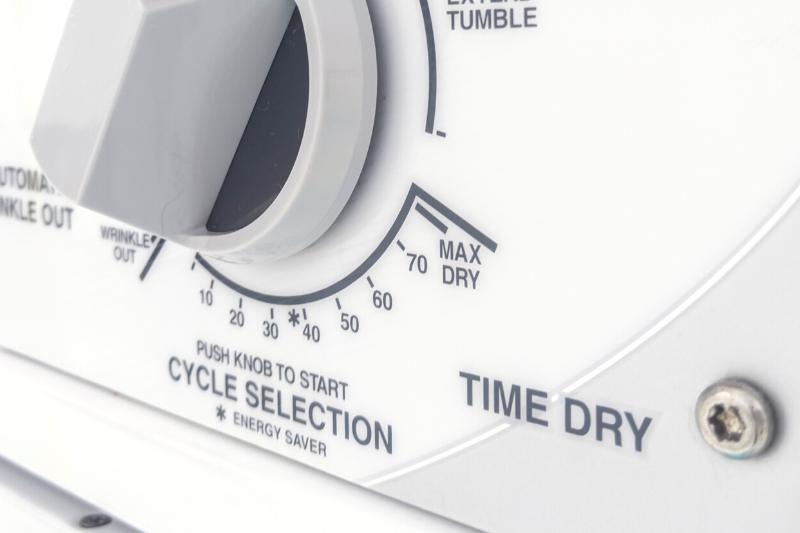
Tumble dryers come with various cycles and you can use these to effectively dry your laundry. Picking the right cycle will also allow your laundry to be dried in an appropriate way, and you’ll know how long each cycle will last.
You can, for example, pick a tumble dryer that comes with a Quick Dry cycle that is as little as 15 minutes long.
Heated airers typically take hours to dry clothes. In some cases they take eight hours to dry items, and other times it’s overnight.
3. Do you have space in your home for either appliance?
You will need to have an actual space to store your tumble dryer in because you won’t be able to move it around freely.
Plus, depending on what type of tumble dryer you buy – condenser, heat pump or vented – you’ll have to position it in a specific space.
A heated airer can be put anywhere in your home, and can be packed away nicely when it’s no longer in use. It is a great space saver for those of you who are short on room in your house.
However, the winged version requires a lot of room, so you may have to reorganise your furniture.
4. Do you have a budget in mind?
Even the cheapest of tumble dryers are usually more expensive to buy than heated airers. Plus, the more extras and fancy tech you add to a tumble dryer the more the price increases!
On a good day you can pick up a very basic heated airer for as little as £40, but you can also get bigger and better ones for around the £200 mark. But either way, these figures are far kinder to your wallet.
5. What type of laundry do you plan on drying?
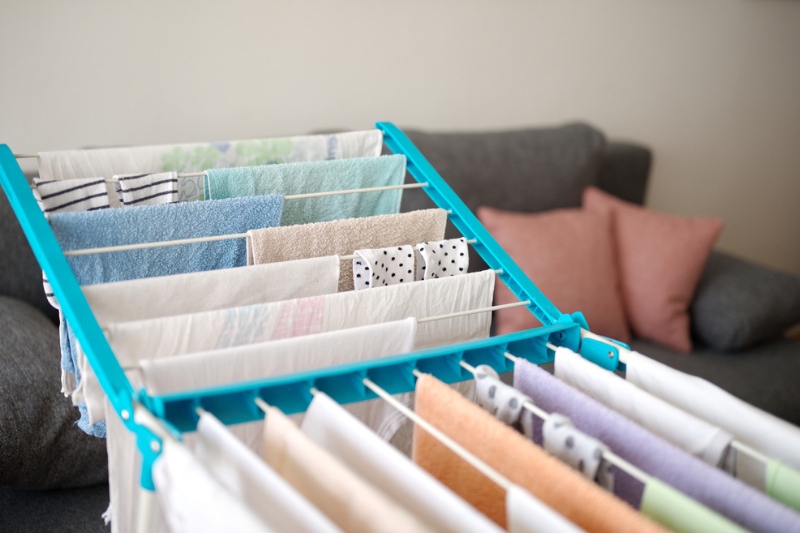
Tumble dryers come with different cycles and you can dry specific materials on these cycles. It usually works out kinder on your laundry to pick the right cycle because your clothes will be dried at the right temperature, and for the right amount of time.
You will see a ‘cotton cycle’ or a ‘denim cycle’ listed on the front of a tumble dryer, for example.
Basic heated airers don’t usually come with fancy cycles, although you may be able to choose a heat setting.
So, you’re not always guaranteed that your clothes will be dried on a setting that is suitable for them. This, in turn, can lead to long drying times.
In addition to this, you can dry bulkier items in a tumble dryer, and although it isn’t impossible to dry bigger items on a heated airer, it can be quite a lengthy drying process and it may not be very practical.

Bethan has a passion for exploring, reading, cooking and gardening! When she’s not creating culinary delights for her family, she’s concocting potions to keep her house clean!
